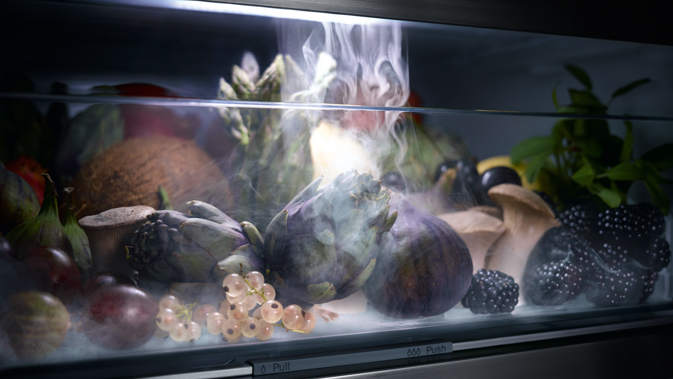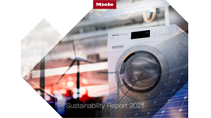Press releases
Waste not, want not: Why food waste is a real problem – and what action Miele is taking

-
Every person in Germany bins on average 75 kg of food each year.
-
Innovative appliances and digital features from Miele help reduce food wastage
A 2019 study has shown that around 12 m tonnes of food find their way onto the rubbish tip each year in Germany. Some estimates even put the figure as high as 18 m tonnes. The good news is that every individual can help to prevent food waste – and Miele offers a whole range of innovative solutions to this end.
The lettuce has limp leaves, the courgettes are slightly bruised, the yoghurt passed its use-by date yesterday – for many, this is reason enough to throw products into the bin. Even though they are still fit for consumption. In Germany, every individual discards on average 75 kg of food a year. The consumer advice centre performed some calculations: '480,000 articulated lorries are necessary to transport the food thrown away each year in Germany. Bumper to bumper, these would stretch from Lisbon to Saint Petersburg'.
But why should this even be a problem – after all, food is in essence a renewable resource? To get to the truth, it is necessary to take a closer look at the resources needed in the production of food: no end of water, energy, labour and agricultural land. These are joined by other negative impact in food production such as CO2 emissions in transporting food from the field to the supermarket. All that is in vain if food is thrown away instead of being eaten. Not forgetting the moral dilemma of dumping edible food while others go hungry.
Furthermore, a current study conducted by the UN Environment Programme comes to the conclusion that 8% to 10% of worldwide greenhouse gases come not from food eaten but from disposal in the processing and distribution chain and by consumers. About a third of this is ascribed to private households. Salvaging food is therefore an important form of climate protection.
Innovative solutions to combat waste in the kitchen and what Miele is doing
With appliances in the homes of many consumers, Miele can leverage efforts to minimise food waste. With the PerfectFresh Pro system from Miele, food stays fresh for up to 5 times longer than in a conventional refrigerator vegetable drawer. The temperature range from 0°C to +3°C offers ideal conditions to extend the shelf life of meat, fish and many dairy products. PerfectFresh Active even goes one step further: Every 90 minutes and every time the door is opened, water aerosol is sprayed directly into the fresher drawer. This combination of low temperatures and humidity helps to avoid premature food spoilage. It also creates the conditions which protect the quality and nutrients in fruit and vegetables.
TasteControl in the oven, on the other hand, prevents food from overcooking or drying out. Once the pre-set cooking time ends, the door opens to the ajar position, and the cooling fan expels hot air. This reduces the temperature by around 100°C within the space of 5 minutes. Then, the oven door closes again automatically, allowing food inside the oven to be actively kept warm at the required temperature.
Modern technology is central to the Smart Food ID feature. In this case, a camera detects the food in the oven and uses an automatic programme to control cooking. This is a feature which provides a valuable service in avoiding food wastage: Smart Food ID reduces the likelihood of food inadvertently burning and having to be thrown away. Miele's CookAssist assumes a similar function: This smart helper makes constant temperature adjustments or even food overcooking a thing of the past. Thanks to step-by-step instructions on a smartphone, food is always cooked to a T. On the hob, Miele's intelligent TempControl sensor guarantees the right temperature at all times by recognising the temperature of cookware and holding it automatically constant.
Miele combi steam ovens, too, offer a special application which avoids food waste and makes good use of leftovers: Mix & Match. In less than half an hour, this function conjures up the most delectable of dishes. Up to three different ingredients, fresh or the previous day's leftovers, can be combined and cooked in a single process. Either directly on a plate or on a baking tray if there are several hungry mouths to feed. A selection of ingredients and suggestions are provided by the Miele app.
Further examples: The aps KptnCook and Plant Jammer, both of which Miele holds a stake in. Plant Jammer suggests personalised recipes using artificial intelligence. The starting point is the individual preferences of users and what is currently available in the fridge. This way, leftovers or a surplus of food can be used up and does not need to be thrown away. The KptnCook recipes are also practical and make healthy and conscious eating particularly easy. Using the app, shopping can be planned and managed precisely – and, if the user so wishes, food can even be ordered directly from the app. Hence, only provisions that are actually needed are purchased. Important in this respect is the food preparation aspect, including deliberately planning meals and menus for the week ahead. Here, too, KptnCook provides support with a selection of suitable recipes and a weekly planner.
And for customers preferring to grow their own herbs and micro-salads, the Plantcube from Agrilution, a Miele subsidiary, is just the job. This modern approach to indoor farming provides a year-round supply of fresh herbs and greens – from the convenience of one's own kitchen. Compared to conventional agriculture, this method requires less soil and water.
Bottom line: When it comes to food waste, we all must chip in
Innovative solutions, like those developed by Miele, are effective in combatting waste. But there also has to be a shift in attitudes among consumers who have the greatest clout in this respect. It is in their power, for example, only to buy what is actually needed, to store food correctly and not to mistake sell-by dates for use-by dates. The more people who act by these simple principles, the less food will end up on landfill sites. A well-rounded approach – not least for the climate!
Company profile: Miele is the world's leading manufacturer of premium domestic appliances including cooking, baking and steam-cooking appliances, refrigeration products, coffee makers, dishwashers and laundry and floor care products. Their product portfolio also includes dishwashers, air purifiers, washing machines and tumble dryers for commercial use as well as washer-disinfectors and sterilisers for use in medical and laboratory applications (Miele Professional). Founded in 1899, the company has eight production plants in Germany, one each in Austria, the Czech Republic, China, Romania and Poland as well as two production plants belonging to its Italian medical technology subsidiary Steelco. Sales in the 2020 business year amounted to around € 4.5 bn (thereof 29.5% in Germany). Miele is represented with its own sales subsidiaries and via importers in
almost 100 countries/regions. Throughout the world, the family-run enterprise, now in its fourth generation, employs a workforce of around 20,900, of which approx. 11,050 employees work in Germany. The company has its headquarters in Gütersloh in Westphalia.
Download as PDF Download incl. media (zip)
Carsten Nagel
+ 49 5241 89-1009
carsten.nagel@miele.com
Media information
| Description | Download |
|---|---|

PerfectFresh Active from Miele for a burst of freshness: Fine water mist envelops the contents of the fresher drawer. In combination with low temperatures, fruit and vegetables stay fresh for as much as 5 times longer. (Photo: Miele) |
|
| High Resolution JPG | |

Thanks to a closed water circuit with an integrated tank, the Plantcube saves over 90% of water compared with conventional agricultural methods. (Photo: Miele) |
|
| High Resolution JPG | |

With its weekly planner, KptnCook allows users to plan their shopping several weeks in advance and to combine dishes to ensure that no food is wasted. (Photo: Miele) |
|
| High Resolution JPG |


